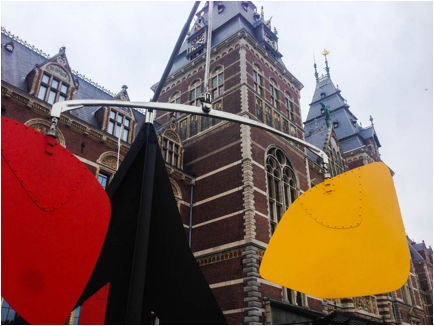Wiley Webb
August 28, 2014 // Amsterdam Trans-Idiomatic Arts Practicum
Alexander Calder – Five Empties, 1973 // Rijksmuseum Lawn
“Five Empties”, a Calder mobile, stands on the eastern lawn of Amsterdam’s Rijksmuseum. One may think it out of place – a 1973 abstract sculpture in front of an old, architecturally-classical Dutch museum and competing with a nearby bronze statue of a nude Greek titan. However, the modernity of its clean lines, smooth curves, and steel material is precisely accentuated by the contrasting background. So, in this way, the museum and the Calder sculptures (there are many both outside and inside the museum) bring out each other’s remarkable qualities. This, in turn, better fulfills the museum’s purpose: to make people notice things and appreciate them. Nothing helps people notice things better than contrast.
The title, “Five Empties”, refers not to the sculpture’s two arms, four legs, six petals/hands, or four fingers, but to the five voids in its legs. The mere act of naming a piece after its negative space declares it as the work’s essence or subject. I was initially attracted to the petals – their bright colours recall flower petals, a clown’s glove, or a baby’s crib mobile. As the wind blows against their broad flat surface, the petals rotate the branches around the stationary black stem; this movement reinforced my initial attention. However, as I explored the piece more closely, I found myself inside the tangle of the black legs, excited by peering through the empties because the overlapping triangular cause even small shifts in perspective to dramatically frame the surrounding environment. This work would be stronger if the empties interacted with the petals in some way; currently it is impossible to see both the petals and the empties simultaneously. But I suppose one advantage of separating the Empties from the petals is that they do not distract from each other – the petals successfully draw in the distant viewer (like flower petals draw in a bee) and, once up close, the empties offer him more complex intrigue.
Formally, Calder’s colours (dark yellow, rich red, black, silver, white) and shapes (the round corners and asymmetry of 50s futuristic graphic design, the Jetsons, lilly pads, cartoon fish-heads and fish-tails) are joyful but not childishly-so, thereby creating a fun yet mature piece. The bright coloured petals are visually and literally heavier, whereas the white ones, which are visually lighter, reach for the sky. Calder could have seamlessly welded the parts together but instead uses welds, bolts, and rivets, which draw attention to the construction, add texture, and make the overall piece more cool, solid, and mature than a whimsical child’s mobile. The paint is matte, which is appropriate for a hardy outdoor piece, and the connecting joints (the arms/branches) comparatively stand out in their shiny silver, with the central top pivot as a small unblinking eye. Their prominence makes you aware of the location and degree of movement of each joint, pushing your appreciation away from the magical whimsy of the piece and towards its impressive engineering.
“Five Empties” absolutely has personality, given dynamism and life by the wind, which can spin it from a whirling aggressive giant into an indecisive, fluttering big softy. Its form evokes that of both flowers (petals, branches, stem) and humans (head, eye, arms, hands, legs), making it easy to empthasise with and anthropomorphise. “Five Empties” is a giant you want to approach and shake its colourful hands, despite its looming height. But as you dance with it, you learn to love not just what its parts are and where they’re located but also where they’re not – their voids, their space, their empties. And just like how a good friend gives you new perspectives on life, the view through Calder’s giant’s empties enables you to see the outer world in more interesting ways.








No comments:
Post a Comment